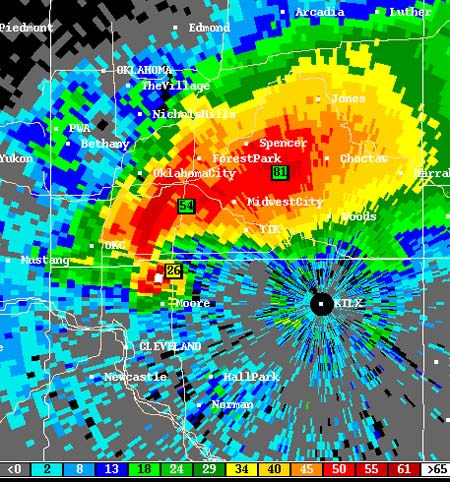Kansas Hailstorm Attenuation
On June 10, 2008, a severe thunderstorm formed in northwest Kansas. This storm produced large hail and strong gusty winds. Here is an example of attenuation. Hail and heavy rain attenuates the radar beam downrange from a heavy rain and hail core. This will cause the radar to underestimate reflectivity behind the highest returns.
According to the book Radar For Meteorologists by Ronald E Rinehart Ph.D., when very strong attenuation takes place there will often be a radial region on the far side of an echo that contains very weak echo or none at all. This attenuation "shadow," as it has been called, is evidence that the storm producing the attenuation is very intense. It may not be clear, however, that the region on the far side of the storm is attenuated. Some innocuous storms have shapes that might naturally produce the same kind of pattern. How can you tell the difference? From a ground-based radar it may be difficult if there are no storms on the far side of the nearest storm. If more distant storms are present, they may give a clue about what the nearer storm is really doing.
Graham County, Kansas, emergency management, reported hail up to the size of softballs. The storm reports indicated that the hail covered the ground.
One note - it is possible that the region of weaker dBZ levels is a bounded weak echo region. It is best to use more than one radar to determine if you are looking at a BWER or simply a problem with attenuation.

Radar scatters energy as it bounces off hail. This causes a weaker dBZ reading behind the hail core

Zoomed in radar image shows the weaker dBZ levels

8:45 PM Anvil blowoff

Anvil blowoff and BWER

8:26 PM - Satellite zoom with shadow

Satellite view of the severe thunderstorm
Satellite loop from WeatherTap.

Eventually this storm grew to a height which allowed the upper level winds to carry the anvil north and northeast. Video of this supercell.

IR Satellite
This thunderstorm went on to produce a bounded weak echo region. This is also known as a BWER. A BWER means that a very strong updraft is present within the thunderstorm. More information on BWER's.
The updraft strength within a thunderstorm will help support hail growth. If the BWER is strong then there is a higher probability of large hail. Again, this storm went on to produce softball size hail.

Goodland, Kansas radar site indicates a BWER. A tornado warning was issued for this storm.

SRV of the same storm.

Cross Section - BWER
More products from the Storm Prediction Center.

Anvil SR winds

Surface to 2km winds

4km to 6km winds

CAPE

